Squash Gardening | Tips for Planting, Maintaining & Harvesting
Fast Facts
- Approximate yields (per 10 feet of row) – 20 to 80 pounds.
- Amount to raise per person – 10 to 20 pounds.
- When treating the garden for insects and diseases, spray or dust during the late afternoon
to avoid killing bees.
- Squash matures rapidly, requiring only 5-7 days from flowering to maturity in hot
weather.
What are the origins of squash?
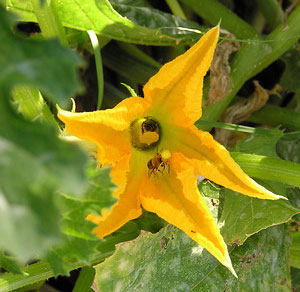
Squash is gourd fruit belonging to the genus Cucurbita. Other edible members of this
family include cucumbers, melons, pumpkins and gourds. Evidence suggests that they
are definitely of American origin. Squash has never been found in a wild state and
has been important in primitive agriculture for centuries.
The earliest cucurbits – probably originating in Mesoamerica – were considerably smaller.
Squash and pumpkin cultivation date back 9,000 years, judging by scattered remains
of seeds and stems found in prehistoric caves in the Tamaulipas mountains of Mexico.
Native American gardens offered a number of varieties of squash. The northeastern
tribes grew pumpkins,
yellow crooknecks, pattypans, Boston marrows (the oldest squash in America still in
commercial production) and turban squash; southern tribes raised winter crooknecks,
cushaws and green and whitestriped sweet potato squash.
Most popular among squashes today is the zucchini, which became popular in American
gardens in the 1950s. It has been reintroduced to this continent from Italy. Italians
acquired the zucchini over 300 years ago and formed a liking for it. The name is a
derivation of an Italian word meaning “sweetest.”
Summer Squash Cultivars
| Crop |
Cultivars |
Days to Maturity |
Seed Per 100 Feet of Row |
| Crookneck |
Dixie F1, Gentry F1, Supersett F1, Sundance F1 |
50 |
2 ounces |
| Straightneck |
Butterstick F1, Early Prolific (AAS winner), Goldbar F1,
Multipik F1, Sunray F1 |
50 |
2 ounces |
| Zucchini |
Ambassador F1, Black Beauty (AAS winner), Cocozelle,
Gold Rush F1 (AAS winner), Spineless Beauty |
50 |
2 ounces |
| Scallop |
Peterpan, Sunburst (AAS winner) |
50 |
2 ounces |
| Other |
Eight Ball F1 (AAS winner), Papaya Pear F1 (AAS winner) |
40 |
2 ounces |
How does summer squash differ from winter squash?
Summer squash (also known as vegetable or Italian marrow) is a tender, warm-season
vegetable. It is grown throughout Arkansas during the frost-free season. Summer squash
differs from winter squash because it is harvested before the rind hardens and the
fruit matures. It grows on bush-type plants that do not spread like the plants of
winter squash and pumpkin. A few plants will produce abundant yields.
Summer squash grows on nonvining bushes. Many varieties have different fruit shapes
and colors.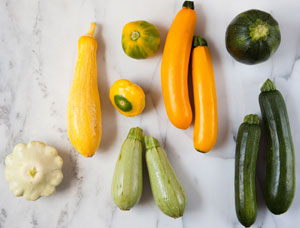
The three main types include:
- yellow (straightneck or crookneck)
- white (saucer-shaped, scallop or pattypan)
- oblong (green, gray or gold zucchini).
The main difference between summer and winter squash is summer squash is eaten when
it is immature and the rind is tender.
When should I plant squash in Arkansas?
Warm soil is necessary for germination of seed and proper growth of plants. Plant
seed directly in the garden after the danger of frost has passed and the soil has
warmed above 62 degrees F in the spring.
This is generally after April 1 in southern Arkansas, April 10-15 in central Arkansas,
and April 21-30 in northern Arkansas and at higher elevations. With ample soil moisture,
summer squash thrives in warm summer weather. A second planting for fall harvest may
be made in mid-July to mid-August.
Grow transplants in a greenhouse for early harvest. Plant seed in deep containers
two to three weeks before the desired planting date. Transplant about three weeks
later after danger of frost. Older plants that have hardened and stopped growing will
not transplant well and should be discarded. Squash is a warm-season plant and does
not do well until soil and air temperatures are above 62 degrees F.
How should I prepare the soil for planting?
Squash grows best in a loamy, well-drained soil. Adjust soil pH as indicated in a
soil test. Soil should have pH 6.0 to 7.5. If the soil test recommends raising the
soil pH, apply agricultural limestone two to four months prior to planting the garden.
We offer free soil testing for Arkansans. Learn how to get your soil tested!
Spacing and Depth of Planting
For single plant production, sow two to three seeds 24 inches apart or three to four
seeds in hills 48 inches apart. Cover 1 inch deep. When the plants are 2 to 3 inches
high, thin to one vigorous plant or no more than two plants per hill.
How do I produced the best yield? Should I fertilize squash plants?
Any well-drained garden soil produces excellent yields of summer squash. Squash plants
are shallow-rooted and require ample soil moisture at all stages of growth. For best
yields, incorporate compost or well-rotted manure before planting. Fertilize the
garden by broadcasting 2 pounds of 10-10-10 fertilizer per 100 square feet of garden
and incorporate into the soil. If transplants are used, apply a transplant fertilizer
starter at the time of planting. Mix one
tablespoon of a soluble fertilizer high in phosphorus (i.e., 10-20-10) into a gallon
of water, and apply one cup of solution per plant.
After harvesting for three or four weeks, sidedress with additional fertilizer; 1
pound of a complete fertilizer per 100 square feet is adequate. This is about 1 or
2 tablespoons of fertilizer per plant. Squash responds to mulching with soil-warming
plastics in early spring or organic materials in summer.
Squash bears male and female flowers on the same plant. Male flowers are formed first,
then the female flowers. Female flowers are characterized by an undeveloped fruit
at the base. Pollination is not always necessary for most summer squash, since it
is harvested at bloom or shortly afterward. Pollen will be transferred from male flowers
to female flowers by bees. Use insecticides late in the afternoon or in the evening to prevent killing bees.
What's wrong with my squash plant?
The most common problems include:
- Diseases – powdery mildew, blossom blight, bacterial wilt, complex virus
- Insects – cucumber beetle, squash vine borer, pickleworm, squash bug
- Cultural – blossom end rot (irregular moisture or calcium deficiency), flower dropping
(may occur normally when female flowers form before male flowers or during periods
of heavy fruit set)
Diseases
Do not handle, harvest or work in the leaves and vines when they are wet to avoid
spreading diseases.
- Powdery mildew is a fungus that attacks the foliage during cool, damp periods. It
is commonly seen in the fall. The surface of the leaf takes on a dusty grey color.
Use a suggested fungicide to control this disease.
- Leaf spots such as anthracnose and septoria will quickly defoliate a plant. These
diseases are caused by a fungus and are controlled by making foliar applications of
a suggested fungicide.
- Belly rot is a soilborne fungal disease that attacks the developing fruit. Use mulches
to prevent fruit contact with the soil.
- Blossom blight is a fungal disease that attacks flowers and young fruit. It appears
during periods of
rainy, humid weather and disappears when the weather dries. Allowing enough space
around the plants for good air circulation will limit this disease.
- Bacterial wilt spread by cucumber beetles is devastating. Plants are infected with
bacterial wilt disease by the natural attack of cucumber beetles. The disease organism
overwinters in the beetles from one year to the next. The beetles hibernate among
the plant debris and weeds around the garden. Plants are usually infected with the
disease-causing bacteria long before they show any symptoms. When the vines wilt
and collapse, it is too late to prevent the disease.
- A number of mosaic virus diseases of squash are spread by leafhoppers. These diseases
include CMV (cucumber mosaic virus), ZYMV (zucchini yellows mosaic virus), WMV2 (watermelon
mosaic virus race 2) and PRSV (papaya ringspot virus). Leaves will be mottled in appearance,
and distorted or twisted growth is common. The symptoms on yellow fruit are the formation
of green spots and warts on the fruit; on zucchini, yellow spots are formed with warts.
Plants are stunted and fruit yield is severely reduced. Plant virus-resistant cultivars
when possible.
For help identifying a disease view the Plant Health Clinic Resources
Insect Pests
Spotted and striped cucumber beetles
Spotted and striped cucumber beetles attack seedlings soon after emergence from the
soil. In certain years, they may attack squash in large numbers and stunt or kill
small plants. Overwintering beetles carry bacterial wilt disease and spread it to
plants when they feed. Control cucumber beetles by applying a suggested insecticide.
Find insecticide recommendations for cucumber beetles
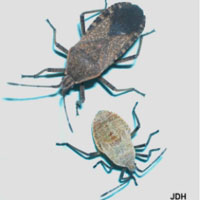 Squash Bugs
Squash Bugs
Squash bugs can be a problem on older plants. They can cause considerable damage to
foliage and may even strip the plant of leaves. These insects are easy to control
when in the nymph stage. As they reach the adult stage, squash bugs are nearly impossible
to control.
For more info, download Squash Bugs in the Home Garden Factsheet
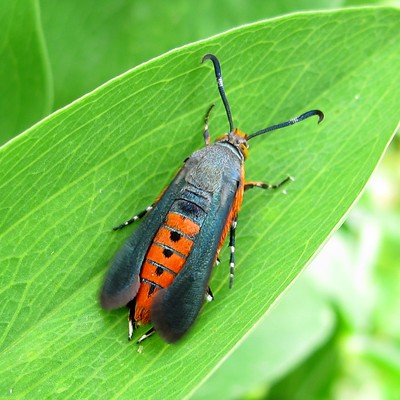 Squash Vine Borers
Squash Vine Borers
Squash vine borers are clear-winged moths that lay eggs near the base of squash vines.
When the larvae enter a stem, little can be done. Chemical control is possible only
if an insecticide is present when young larvae hatch from the egg prior to entering
the plant
For more info, download Squash Vine Borer Control Factsheet
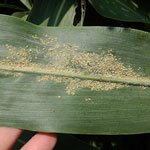 Aphids
Aphids
Watch for buildup of colonies of aphids on the underside of the leaves. Use a suggested
insecticide if colonies appear.
For more info, see our
Summer Pest Control page
When should I harvest?
To get the best quality summer squash, harvest when small and tender. 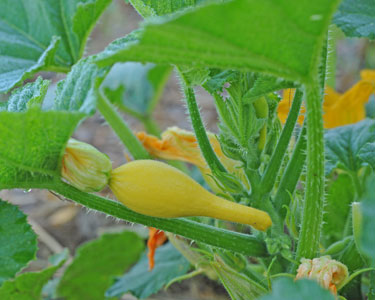
- Harvest most elongated varieties when 1 1/2 to 2 inches in diameter or 6 to 8 inches
long.
- Harvest pattypan types when 3 to 4 inches in diameter.
Harvest when immature only (days to maturity – 50 to 65). If the rind is too hard
to be marked by the thumbnail, it is too old. Do not allow summer squash to become
large, hard and seedy.
Remove over-sized squash and discard to maintain the yield potential of the plants.
Squash grows rapidly and is usually ready to pick within two to four days after flowering.
Although summer squash has both male and female flowers, only the female flowers produce
fruit. Since the fruit is immature when harvested, it bruises easily. Handle with
care and use immediately after picking. Some gardeners also pick the open blossoms
before the fruit develops. These blossoms are a delicacy when dipped in batter and
fried.
What's the best way to store and prepare my harvest?
Store in a cool (40 to 50 degrees F), moist (95 percent relative humidity) conditions;
5 to 14 days.
There are many ways to enjoy squash. It can be cooked, eaten raw, or even preserved
as pickles and relishes.
Find recipes for cooking squash
View our pickling resources
Frequently Asked Questions
Yes. Any squash or pumpkin within the same species will cross-pollinate, but cross-pollination
will not affect this year’s crop.
Yes. Squash can be transplanted when the plants are young (15 to 20 days old) and
have been started in containers. Large vine crops do not transplant well. Many gardeners
place two seeds in a 3-to 4-inch deep pot in late March and early April to start
a few squash plants for spring harvest
Your problem is probably squash vine borer, and if it is, the white, grub-like larvae
can be found within the stem of the plant by cutting it open. The larvae hatch from
eggs laid by bright-colored, wasp-like moths on the foliage or stems. The eggs hatch,
and the larvae travel down the plant to the stem and literally “core it out.” To prevent
this problem, begin control measures about the time the plants start to bloom by applying
an insecticide to the base of the plant.
Once grubs are inside the stem, they are almost impossible to control. During the
fall growing season, begin treatment shortly after plant emergence.
No. Vine borers cannot be controlled effectively with insecticides once they have
infested the plants. Dispose of the infested plants to reduce potential damage in
following seasons. Apply insecticide before vines are infested.
Squash plants produce male and female flowers. For fruit to set, pollen must be transferred
from the male to the female flower by pollinating insects, mostly bees. When treating
the garden for insects and diseases, spray or dust during the
late afternoon to avoid killing bees. Nematode infestations can also cause this problem,
so check roots for galls.
Squash matures rapidly, requiring only five to seven days from flowering to maturity
in hot weather! Harvest every other day in hot weather.
Good yellow summer squash should be 1 1/2 to 2 inches in diameter at the base and
pale yellow in color. If overripe fruit is not removed, the plant will stop yielding.
Yes, but this is not a recommended practice. Squash has male and female blooms and
needs bees for pollination. Seeds saved from this year’s crop probably will not breed
true when planted next year. This is especially true if more than one
type of squash variety or a hybrid squash, such as Dixie, is grown.
This is Chaonephora fruit rot or blossom blight, a soilborne disease. It rots young fruits and is damaging
to them during extended wet periods.
It can be controlled with a combination of treatments to reduce the humidity around
the plant, such as using raised beds and open foliage. This allows air movement to
dry the soil and the foliage. Avoid planting squash on heavy, poorly
drained soils.
Still have questions? Contact your local county Extension agent.
This information came from our Home Gardening Series Squash Gardening
 Aphids
Aphids

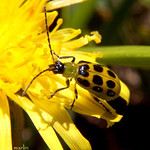
 Squash Bugs
Squash Bugs Squash Vine Borers
Squash Vine Borers